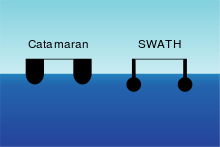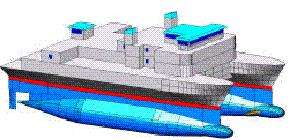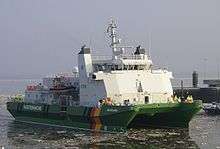Small-waterplane-area twin hull


A Small Waterplane Area Twin Hull, better known by the acronym SWATH, is a twin-hull ship design that minimizes hull cross section area at the sea's surface. Minimizing the ship's volume near the surface area of the sea, where wave energy is located, maximizes a vessel's stability, even in high seas and at high speeds. The bulk of the displacement necessary to keep the ship afloat is located beneath the waves, where it is less affected by wave action. Wave excitation drops exponentially as depth increases (deeply submerged submarines are normally not affected by wave action at all). Placing the majority of a ship's displacement under the waves is similar in concept to creating a ship that rides atop twin submarines.
Effects
The twin-hull design provides a stable platform and large, broad decks. Compared with conventional catamarans, SWATH vessels have more surface drag, but less wave drag, they are less susceptible to wave motion but more sensitive to payload, which affects draught. Additionally, SWATH vessels cannot operate in planing or semi-planing modes and thus gain no drag reduction when operating at speeds normally associated with such modes.[1], require a complex control system, have a deeper draft, and have higher maintenance requirements. The design of SWATH vessels is also considerably more complex due to the structural complexities inherent to the design.[2]
History
The SWATH form was invented by Canadian Frederick G. Creed, who presented his idea in 1938, and was later awarded a British patent for it in 1946. The first full-scale SWATH vessel to be built and put into productive service was MV Duplus,[3] a diving support vessel built in the Netherlands in 1968. In the 1970s, several units were built in different countries (including SSC Kaimalino by the US Navy,[4] and an 80-ft ferry in Japan). Since the 1980s, oceanographic research vessels, pilot tenders, yachts and other craft are more routinely being built with the SWATH hull type.[5]
Specific examples


- Duplus (1969), an oil industry support ship, the first SWATH ship ever built
- CCGS Frederick G. Creed, a Canadian Coast Guard survey ship
- Sea Shadow, a US Navy experimental stealth ship
- Sea Fighter, a US Navy experimental littoral combat ship
- MV China Star (formerly the Radisson Diamond): a 350-person all balcony luxury cruise ship, the largest SWATH ship in the world when it was built, displacing more than 11,500 tons.
- RV Kilo Moana (T-AGOR-26), a University of Hawaii oceanographic research vessel
- Planet Type 752, weapons + sonar research ship of the German Navy vessel
- USNS Impeccable (T-AGOS-23), a U.S. Navy Impeccable-class ocean surveillance ship
- Silver Cloud, a 135' private yacht.
- Skrunda-class patrol boat
See also
- Multihull
- M80 Stiletto
- Catamaran
- Sea Slice, an experimental US Navy ship with multiple SWATH hulls.
- Semisubmersible
- Trimaran
- Wave-piercing hull
References
- ↑ Misra, Suresh Chandra (2015). Design Principles of Ships and Marine Structures. CRC Press. p. 474. ISBN 9781482254471.
- ↑ Busch, Ian Richard (1990), On the Cost Effectivelness of Large Commercial SWATH Vessels, Cambridge: Massachusetts Institute of Technology, Department of Ocean Engineering, p. 418
- ↑ "Boele-Bolnes launch twin-hull craft for offshore work". Holland Shipbuilding. 17 (9): 58. 1968.
- ↑ LaPuzza, Tom (March 2005). "SSC San Diego Command History Calendar Year 2004" (PDF). United States Navy SSC SAN DIEGO.
- ↑ Arps, Jan L. (May 1973). "The Role of the Semi-Submersible Work Vessel In Offshore Production Operations". Fifth Annual Offshore Technology Conference. Offshore Technology Conference. doi:10.4043/1867-MS. ISBN 978-1-55563-659-3.
External links
| Wikimedia Commons has media related to SWATH. |